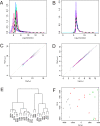Gene expression profiling of two distinct neuronal populations in the rodent spinal cord
- PMID: 18923679
- PMCID: PMC2566599
- DOI: 10.1371/journal.pone.0003415
Gene expression profiling of two distinct neuronal populations in the rodent spinal cord
Abstract
Background: In the field of neuroscience microarray gene expression profiles on anatomically defined brain structures are being used increasingly to study both normal brain functions as well as pathological states. Fluorescent tracing techniques in brain tissue that identifies distinct neuronal populations can in combination with global gene expression profiling potentially increase the resolution and specificity of such studies to shed new light on neuronal functions at the cellular level.
Methodology/principal findings: We examine the microarray gene expression profiles of two distinct neuronal populations in the spinal cord of the neonatal rat, the principal motor neurons and specific interneurons involved in motor control. The gene expression profiles of the respective cell populations were obtained from amplified mRNA originating from 50-250 fluorescently identified and laser microdissected cells. In the data analysis we combine a new microarray normalization procedure with a conglomerate measure of significant differential gene expression. Using our methodology we find 32 genes to be more expressed in the interneurons compared to the motor neurons that all except one have not previously been associated with this neuronal population. As a validation of our method we find 17 genes to be more expressed in the motor neurons than in the interneurons and of these only one had not previously been described in this population.
Conclusions/significance: We provide an optimized experimental protocol that allows isolation of gene transcripts from fluorescent retrogradely labeled cell populations in fresh tissue, which can be used to generate amplified aRNA for microarray hybridization from as few as 50 laser microdissected cells. Using this optimized experimental protocol in combination with our microarray analysis methodology we find 49 differentially expressed genes between the motor neurons and the interneurons that reflect the functional differences between these two cell populations in generating and transmitting the motor output in the rodent spinal cord.
Conflict of interest statement
Figures




Similar articles
-
Synaptic targets of commissural interneurons in the lumbar spinal cord of neonatal rats.J Comp Neurol. 2003 Jul 7;461(4):429-40. doi: 10.1002/cne.10696. J Comp Neurol. 2003. PMID: 12746860
-
Notch1 signaling influences v2 interneuron and motor neuron development in the spinal cord.Dev Neurosci. 2006;28(1-2):102-17. doi: 10.1159/000090757. Dev Neurosci. 2006. PMID: 16508308
-
MicroRNAs mediate precise control of spinal interneuron populations to exert delicate sensory-to-motor outputs.Elife. 2021 Mar 31;10:e63768. doi: 10.7554/eLife.63768. Elife. 2021. PMID: 33787491 Free PMC article.
-
Probing the transcriptome of neuronal cell types.Curr Opin Neurobiol. 2006 Oct;16(5):571-6. doi: 10.1016/j.conb.2006.08.006. Epub 2006 Sep 7. Curr Opin Neurobiol. 2006. PMID: 16962313 Review.
-
Neuronal apoptosis revealed by genomic analysis: integrating gene expression profiles with functional information.Neuroinformatics. 2007 Summer;5(2):115-26. doi: 10.1007/s12021-007-0006-3. Neuroinformatics. 2007. PMID: 17873373 Review.
Cited by
-
Transcriptional regulation of gene expression clusters in motor neurons following spinal cord injury.BMC Genomics. 2010 Jun 9;11:365. doi: 10.1186/1471-2164-11-365. BMC Genomics. 2010. PMID: 20534130 Free PMC article.
-
Functional genomics unique to week 20 post wounding in the deep cone/fat dome of the Duroc/Yorkshire porcine model of fibroproliferative scarring.PLoS One. 2011 Apr 20;6(4):e19024. doi: 10.1371/journal.pone.0019024. PLoS One. 2011. PMID: 21533106 Free PMC article.
-
Effects of Chronic Spinal Cord Injury on Relationships among Ion Channel and Receptor mRNAs in Mouse Lumbar Spinal Cord.Neuroscience. 2018 Nov 21;393:42-60. doi: 10.1016/j.neuroscience.2018.09.034. Epub 2018 Sep 30. Neuroscience. 2018. PMID: 30282002 Free PMC article.
-
Weight-bearing locomotion in the developing opossum, Monodelphis domestica following spinal transection: remodeling of neuronal circuits caudal to lesion.PLoS One. 2013 Aug 12;8(8):e71181. doi: 10.1371/journal.pone.0071181. eCollection 2013. PLoS One. 2013. PMID: 23951105 Free PMC article.
References
-
- Diaz E. A functional genomics guide to the galaxy of neuronal cell types. Nat Neurosci. 2006;9:10–12. - PubMed
-
- Shoemaker DD, Linsley PS. Recent developments in DNA microarrays. Curr Opin Microbiol. 2002;5:334–337. - PubMed
-
- Nelson SB, Hempel C, Sugino K. Probing the transcriptome of neuronal cell types. Curr Opin Neurobiol. 2006;16:571–576. - PubMed
-
- Nelson SB, Sugino K, Hempel CM. The problem of neuronal cell types: a physiological genomics approach. Trends Neurosci. 2006;29:339–345. - PubMed
Publication types
MeSH terms
LinkOut - more resources
Full Text Sources
Molecular Biology Databases
Research Materials

